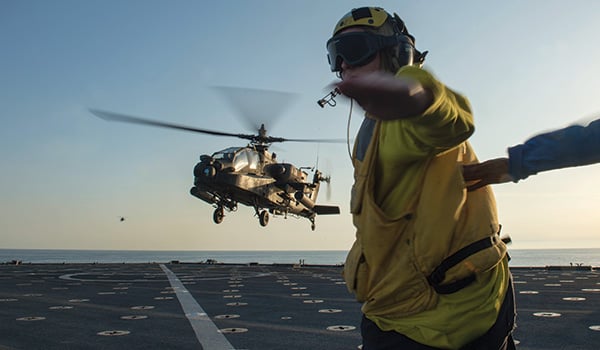
AMRDEC Tech Talk / By Mr. Les Wiggins and Mr. Frank Collins: One of the more memorable days in an Army Aviator’s career can include joint operations with a U.S. Navy vessel. However, hidden in the scenic beauty of that nautical scene can lie dangers and risks that have the potential of ruining your trip.

An Army AH-64 Apache helicopter takes off from the flight deck of the dock landing ship USS Oak Hill (LSD 51), Jan. 5, 2016./ U.S. NAVY PHOTO BY MASS COMM SPEC. 2ND CL. JUSTIN YARBOROUGH
It is important to note that while the Airworthiness Release (AWR) issued for your aircraft may not restrict shipboard operation that does not mean your aircraft has been qualified for shipboard operation. Qualification for shipboard operation is usually not a requirement for Army aircraft programs and is typically not included in developmental testing. Even though your aircraft type may have conducted shipboard operations in the past that does not mean your current aircraft series is qualified for shipboard operations. For example, the expanded wind envelop that was developed for the CH-47D under the Joint Shipboard Integration Process (JSHIP) program does not apply to the CH-47F. Also, successful operation with a single ship does not qualify an aircraft for all ship types and sea conditions. The U.S. Navy NAVAIR Publication, Shipboard Aviation Facilities Resume (NAEC-ENG-7576), which is revised annually, lists DoD aircraft qualification by ship hull number.
While your unit commander may accept the risk of shipboard operation, the captain of the ship has final say. The ship captain maintains control of when you can approach the ship, which landing spot to use, and the status of your aircraft while aboard. During the Vietnam War, for example, aircraft were pushed overboard to free up needed deck space for arriving aircraft at the direction of the captain.
HAZARD – Electromagnetic Environment Effects (E3). Shipboard surface and air radars and other shipboard emitters can create an electromagnetic field with intensities and frequencies that are hazardous to your aircraft. This has the potential of causing misbehavior of various aircraft systems such as the fly-by-wire engine controllers (FADEC), navigation systems, communication systems, flight control systems (SCAS, Hold Modes), weapon systems, survivability systems (Chaff/flares), etc. For this reason, ships are instructed not to energize specific emitters while certain aircraft approach when potential conflicts are known to exist. Similarly, it may be wise to turn off aircraft systems that have not been approved for shipboard operation whenever possible.
Risk Mitigation – Aircrews embarking upon a Naval vessel should obtain and review the AED classified HIRTA message for shipboard emitters and obtain an E3 brief from the ship including electromagnetic control (EMCON) and Hazards of Electromagnetic Radiation to Ordnance (HERO) procedures.
HAZARD – Air Wake Turbulence. The wake in the water behind a ship is clearly visible, the air wake created by the ship as it moves through the atmosphere is unseen and difficult to predict. As an aviator approaches a ship, he should expect to encounter a variety of vortices and gusts that can buffet the aircraft laterally and vertically. As your rotor wash interacts with the ship deck and super structure, your aircraft can experience rapidly changing gusts that differ from the nose to the tail of your aircraft. These rapidly changing ship wake gusts can cause erroneous wind indications in your aircraft systems as well as heavy buffet. Excessive blade flapping and rotor hub damage can occur during shutdown as the rotor RPM decreases and the turbulent air around the ship buffets the aircraft (use your rotor break if equipped). Remember to secure the rotor during tie down.
HAZARD – Additional hazards. The ship will continue to pitch, roll, and translate through the water, and change heading once you are on deck. Your aircraft may attempt to maintain a heading or attitude independent of ship motion if a HOLD Mode is engaged. Your navigation system may have trouble realigning on startup due to the excess motions. Unless your aircraft has undergone shipboard dynamic interface testing, many of the hazards and issues will not be documented.
Risk Mitigation – Obtain a copy of the NATOPS manual for the type of ship on which you plan to operate and review arrival/departure procedures, wind envelopes, and other information. The following manuals can be downloaded from military publication websites and the AED also maintains a copy: the CV NATOPS (NAVAIR 00-80T-105) pertains to carrier operations, the LHA/LHD NATOPS (NAVAIR 00-80T-106), and the Air Capable Ship NATOPS (NAVAIR 00-80T-122) for operations with all other ship types.
Before conducting exercises with U.S. Navy or other ships, consider contacting the AED for recommended operating practices and cautions unique to your aircraft and ship type.
Mr. Les Wiggins and Mr. Frank Collins are engineers with the Aviation Engineering Directorate of the U.S. Army Aviation and Missile Research, Development, and Engineering Center at Redstone Arsenal, AL.










